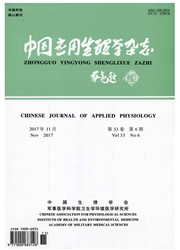

 中文摘要:
中文摘要:
目的:观察在不同温度条件下脊髓星形胶质细胞划痕损伤活化后的形态和活性改变,以探讨亚低温对脊髓损伤后反应性星形胶质细胞增生的影响。方法:体外原代培养新生SD大鼠脊髓星形胶质细胞,以划痕实验制备反应性星形胶质细胞。亚低温选择33%,细胞培养48h。实验分为对照组、划痕组、亚低温组和划痕+亚低温组。各组在相应的时间点观察细胞形态,采用免疫荧光染色方法检测Nestin阳性率,MTT比色法观察细胞活性,PI染色方法观察细胞凋亡程度。结果:与对照组和亚低温组相比,划痕组和划痕+亚低温组细胞胞体肥大,周围突起增多、延展以及胞浆丰富,细胞生长率明显升高。与划痕组相比,划痕+亚低温组细胞变化减慢,周围突起减少,细胞长入划痕处所需时间增加,细胞Nestin阳性率、PI阳性率和细胞生长率明显降低,各结果差异显著(P〈0.01)。结论:划痕损伤后星形胶质细胞活化为反应性星形胶质细胞并会增生,亚低温明显抑制脊髓反应性星形胶质细胞的活化增生,并可以抑制星形胶质细胞的凋亡。
 英文摘要:
英文摘要:
Objective: To observe changes in the morphology and activity of astrocytes in spinal cord at different temperatures 'after scratches treatment, and to investigate the effect of mild hypothermia on hyperplasia of reactive astrocytes. Methods: Spinal cord astrocytes were cultured from the neonatal SD rat, and reactive astrocytes were prepared by scratches treatment. Mild hypothermia choose 33 ℃, cell culture 48 h. Cells were divided into control group, scratches group, mild hypothermia group and scratch + mild hypothennia group. Cell morphology of each group were observed in 0 h,6 h, 12 h ,24 h ,48 h ,3 d,5 d ,7 d. Nestin positive rate were detected by using immunofluorescence staining method. Cell activity were observed by methyl thiazolyl tetrazolium salt (MTF) assay. The degree of apoptosis was observed by using PI staining method. Results: Compared with control group and mild hypothennia group, cell body in both scratches group and scratch + mild hypothennia group was hypertrophy, the protrusion around was increased and extend, the cytoplasm was enrich, and the growth rate was significantly increased. Compared with scratches group, scratch + mild hypothermia group cells grew slowly, the protrusion around was decreased, and cells of the scratched area ingrowth significantly slowly. Nestin and PI positive rate of ceils were also significantly lower. All the results had statistically significant differences ( P 〈 0.01 ). Conclusion: After scratch injury, astroytes were activated to be reactive astrocytes and hyperplasia. Mild hypothemfia significantly inhibited spinal cord reactive astrocytes overgrowth and restrain astrocytes apoptosis.
 同期刊论文项目
同期刊论文项目
 同项目期刊论文
同项目期刊论文
 期刊信息
期刊信息
